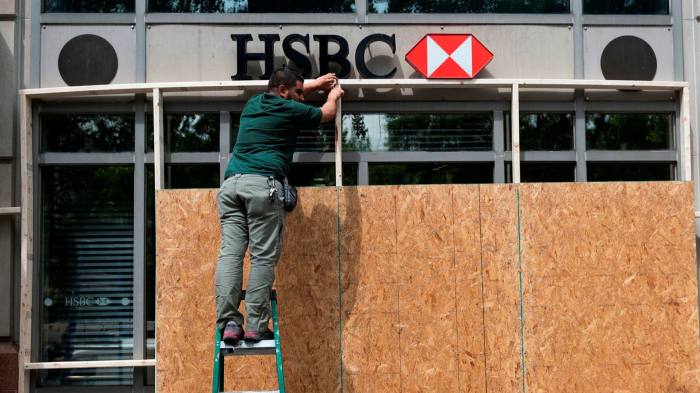HSBC considers exit from US retail banking

HSBC is weighing up a complete exit from retail banking in the US after narrowing the options for how to improve performance at its struggling North America business, according to two people familiar with the situation.
Senior management aim to present the plan to the bank’s board in the coming weeks, the people said, as HSBC seeks to allocate resources away from the US in favour of more profitable businesses in Asia.
Closure of the US retail network would mark the end of the lender’s 40-year long attempt to run a full-service, universal bank in the country. The division made a pre-tax loss of $518m in the first three quarters of this year, following losses of $279m last year and $182m in 2018.
HSBC’s American division has been under intense scrutiny for several months as part of the UK lender’s efforts to make even deeper savings than it pledged in February, when it outlined $4.5bn in cost savings and 35,000 job cuts.
Executives decided the impact of the coronavirus crisis and a prolonged period of ultra-low interest rates required more drastic measures, the Financial Times reported in May.
A full exit from the US is no longer on the table, according to the two people. “The US is an important marketplace,” one said, particularly for HSBC’s investment bank. It is also seeking to grow its US wealth management division.
Managers are likely to also recommend trimming HSBC’s investment bank client roster to focus on international clients, particularly those with Asian and Middle Eastern links, the people said.
Those with only domestic US business, which are less profitable and where HSBC struggles to find an edge against larger Wall Street rivals like JPMorgan and Citigroup, will be de-emphasised. The bank said in the third quarter it had already eliminated $4bn of risk-weighted assets in its US business through “client optimisation”.
Following the closure of 80 branches this year, HSBC has around 150 branches on the east and west coast of America, a fraction of the branch network of JPMorgan and Bank of America.
Some insiders argued that the division’s lack of scale makes it hard to turn round, especially in the current economic environment.
Against this backdrop, there is a strong case for completely leaving retail banking, according to one person familiar with the situation. Another option is to adopt a digital-only model focused on international clients from the Chinese or Indian diaspora, although that is a “crowded market”, the person added.
The biggest US banks have been investing heavily in their digital offerings, where online-only players including BBVA’s Simple and Goldman Sachs’ Marcus compete with European fintechs like N26 and Monzo, which launched in the US last year.
HSBC has not made a final decision on the future of its US retail business. “The jury is still out . . . we are examining the financial viability of the cost and the reward of exiting or having a middle strategy where we keep a smaller presence,” one of the people said. The timeframe for a decision could slip to next year. HSBC declined to comment.
At the bank’s third-quarter results last month, HSBC chief executive Noel Quinn pledged to go “further and faster on our cost and risk-weighted asset reduction programmes”, after setting aside $7.7bn for potential loan losses during the pandemic. The lender’s share price is down almost a third this year.
HSBC first entered the US consumer market in the 1980s. A disastrous acquisition of subprime mortgage lender Household International in 2003 caused the bank billions in losses and resulted in misconduct penalties after the financial crisis. It sold off half its branch network and a profitable $30bn credit card business in 2011.
Since then, successive executives have debated how best to restore the US retail operation to sustainable profitability, without much success. It lacks high-margin earnings from unsecured credit card lending, and the subscale wealth and branch network have rarely made money.
No comments:
Post a Comment